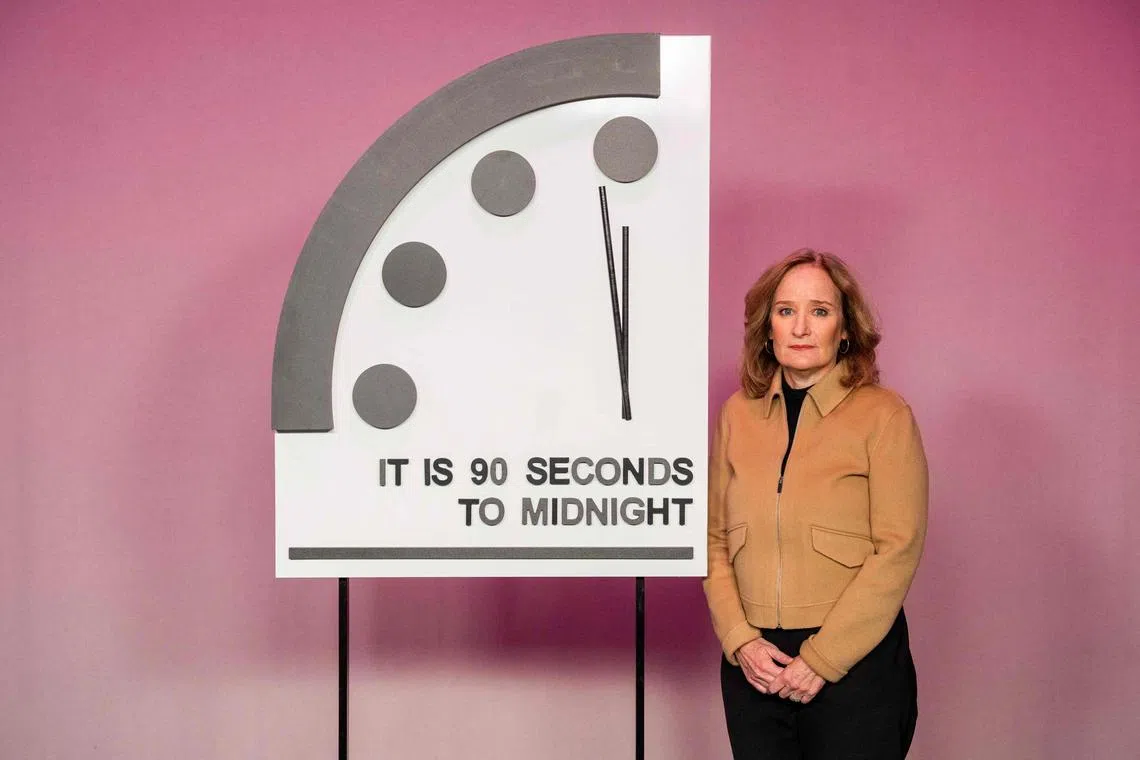Atomic scientists keep ‘Doomsday Clock’ as close to midnight as ever
Sign up now: Get ST's newsletters delivered to your inbox

Dr Rachel Bronson standing next to the Doomsday Clock, which warns the public how close humankind is to destroying the world.
PHOTO: AFP
Follow topic:
WASHINGTON – Atomic scientists on Jan 23 kept their “Doomsday Clock” set as close to midnight as ever before, citing Russia’s actions on nuclear weapons amid its invasion of Ukraine, nuclear-armed Israel’s Gaza war and worsening climate change as factors driving the risk of global catastrophe.
Non-profit organisation Bulletin of the Atomic Scientists, as it did in 2023, set the clock at 90 seconds to midnight – the theoretical point of annihilation. Scientists set the clock based on “existential” risks to earth and its people: nuclear threats, climate change and disruptive technologies such as artificial intelligence and new biotechnology.
“Conflict hot spots around the world carry the threat of nuclear escalation, climate change is already causing death and destruction, and disruptive technologies like AI and biological research advance faster than their safeguards,” Dr Rachel Bronson, the Bulletin’s president and chief executive, told Reuters, adding that keeping the clock unchanged from the prior year is “not an indication that the world is stable”.
The Chicago-based organisation created the clock in 1947 during the Cold War tensions that followed World War II, to warn the public about how close humankind was to destroying the world. It said on Jan 23 that ominous trends continue to point towards catastrophe, including the fact that China, Russia and the United States all are spending large amounts of money to expand or modernise their nuclear arsenals,
Russia’s full-scale invasion of Ukraine,
“A durable end to Russia’s war in Ukraine seems distant, and the use of nuclear weapons by Russia in that conflict remains a serious possibility. In the past year Russia has sent numerous worrying nuclear signals,” Dr Bronson said.
She cited Russian President Vladimir Putin’s February 2023 decision to suspend Russian participation in the New Start treaty
Dr Bronson additionally cited Mr Putin’s March 2023 announcement of Russia’s deployment of tactical nuclear weapons in Belarus
Traditional nuclear arms control has come to an end for now even as a three-way nuclear arms race is shaping up among China, Russia and the United States, said Associate Professor Alexander Glaser of Princeton University, a member of the Bulletin’s board of experts on nuclear technology and climate science.
“The picture is quite bleak on the nuclear side this year,” Prof Glaser added.
Israel has been at war with Hamas since the Palestinian Islamist group, based in Gaza, launched attacks in southern Israel in October 2023.
“As a nuclear state, Israel’s actions are clearly relevant to the Doomsday Clock discussion. Of particular worry is that the conflict might escalate more broadly in the region, creating a larger conventional war and drawing in more nuclear powers or near-nuclear powers,” Dr Bronson said.
Climate change was added in 2007 as a factor
“The world in 2023 entered into uncharted territory as it suffered its hottest year on record and global greenhouse gas emissions continued to rise,” Dr Bronson said. “Both global and North Atlantic sea-surface temperatures broke records, and Antarctic sea ice reached its lowest daily extent since the advent of satellite data.”
She said that while 2023 was a record-breaking year for clean energy with US$1.7 trillion (S$2.28 trillion) in new investments, fossil fuel investments totalled nearly US$1 trillion. Dr Bronson called current efforts to reduce greenhouse gas emissions “grossly insufficient to avoid dangerous human and economic impacts from climate change, which disproportionately affect the poorest people in the world”.
The Bulletin was founded in 1945 by scientists, including Albert Einstein and J. Robert Oppenheimer. REUTERS

